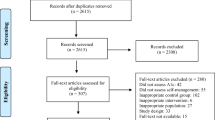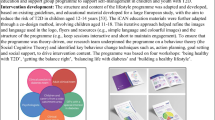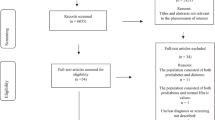Abstract
The transtheoretical model of behavior change has become one of the most influential theoretical models within health psychology. Characterized by treating behavior change as a dynamic process, it has recently been applied to diabetes mellitus. Both interventional and observational studies have applied the transtheoretical model to the care of patients with diabetes in multiple settings; the studies that have been performed have been very heterogeneous in nature. Pooled data from these studies yielded a distribution that describes patients across the stages of change, the main construct of the transtheoretical model. Regarding treatment effectiveness, the empirical data reported in the studies showed that participants did progress through the stages of change when a transtheoretical model-based intervention was applied, and that a higher percentage of participants progressed in the intervention groups than in the control groups. Further research is needed in this field to obtain more information about the constructs of the transtheoretical model and the stages of change. The use of validated questionnaires in the assessment process is also recommended. The studies included in this review show how the transtheoretical model has made a positive contribution to interventions in the field of diabetes.









Similar content being viewed by others
References
Highstein GR, O’Toole ML, Shetty G, et al. Use of the transtheoretical model to enhance resources and supports for diabetes self management. Diabetes Educ 2007; 33: 193S–200S
Ruderman N, Devlin JT. The health professional’s guide to diabetes and exercise. Alexandria (VA): American Diabetes Association, 1995
Hwang AR, Yoo JS, Lee HC, et al. The effects of exercise therapy applied in an efficacy expectation-promoting program on self-efficacy, cardiopulmonary function, and metabolism in type 2 diabetes mellitus patients. J Korean Biol Nurs Sci 2000; 2: 64–75
Hays L, Clark D. Correlates of physical activity in a sample of older adults with type 2 diabetes. Diabetes Care 1999; 22: 706–12
Ford E, Herman W. Leisure time physical activity patterns in the US diabetic population: findings from the 1990 national health interview survey. Diabetes Care 1995; 18: 27–33
UK Prospective Diabetes Study (UKPDS) Group. Intensive blood-glucose control with sulphonylureas or insulin compared with conventional treatment and risk of complications in patients with type 2 diabetes (UKPDS33). Lancet 1998; 32: 837–53
Ellis E. Towards evidence-based practice: the role of the dietitian in the management of diabetes. Pract Diab Int 1999; 16: 142–4
Prochaska JO, DiClemente CC. Stages and processes of self-change in smoking: towards an integrative model of change. J Consult Clin Psychol 1983; 51: 390–5
Prochaska JO, DiClemente CC, Norcross JC. In search of how people change: applications to addictive behaviours. Am Psychol 1992; 47: 1102–14
Ruggiero L. Helping people with diabetes change behavior: from theory to practice. Diabetes Spectr 2000; 13: 125–37
Velicer WF, Prochaska JO, Fava JL, et al. Smoking cessation and stress management: applications of the transtheoretical model of behavior change. Homeost 1998; 38: 216–33
Janis IL, Mann L. Decision making: a psychological analysis of conflict, choice, and commitment. London: Cassel & Collier Macmillan, 1977
Bandura A. Toward a unifying theory of behavioral change. Psychol Rev 1977; 84: 191–215
Norris SL, Engelgau MM, Narayan KMV. Effectiveness of self-management training in type 2 diabetes. Diabetes Care 2001; 24: 561–87
Marcus BH, Emmons KM, Simkin SL, et al. Evaluation of motivationally tailored versus standard self-helped physical activity interventions at the workplace. Am J Health Promot 1998; 12: 246–53
Kim CJ, Hwang AR, Yoo JS. The impact of a stage-matched intervention to promote exercise behavior in participants with type 2 diabetes. Int J Nurs Stud 2004; 41: 833–41
Riesma RP, Pattenden J, Bridle C, et al. Systematic review of the effectiveness of stage based interventions to promote smoking cessation. BMJ 2003; 326: 1175–7
Rosen CS. Is the sequencing of change processes by stage consistent across health problems? A meta-analysis. Health Psychol 2000; 19: 593–604
Adams J, White M. Are activity promotion interventions based on the transtheoretical model effective? A critical review. Br J Sports Med 2003; 37: 106–14
Berlin JA. Invited commentary: benefits of heterogeneity in meta-analysis of data from epidemiologic studies. Am J Epidemiol 1995; 142(4): 383–7
Amati F, Barthassat V, Miganne G, et al. Enhacing regular physical activity and relapse prevention through a 1-day therapeutic patient education workshop: a pilot study. Patient Educ Couns 2007; 68: 70–8
Crespo R, Shrewsberry M. Factors associated with integrating self-management support into primary care. Diabet Educ 2007; 33 Suppl. 6: 126s–31s
Griffin JA, Gilliland SS, Perez G, et al. Participant satisfaction with a culturally appropiate diabetes education program: the Native American diabetes project. Diabetes Educ 1999; 25: 351–63
Jackson R, Asimakopoulout K, Scammell A. Assessment of the transtheoretical model as used by dietitians in promoting physical activity in people with type 2 diabetes. J Hum Nutr Diet 2007; 20: 27–36
Jones H, Edwards L, Vallis TM, et al. Changes in diabetes self-care behaviors make a difference in glycemic control: the Diabetes Stages of Change (DiSC) study. Diabetes Care 2003; 26: 732–7
Kasila K, Poskiparta P, Karhila P, et al. Patients’ readiness for dietary change at the beginning of counseling: a transtheoretical model-based assessment. J Hum Nutr Diet 2003; 16: 159–66
Kirk AF, Higgins LA, Hughes AR, et al. A randomized, controlled trial to study the effect of exercise consultation on the promotion of physical activity in people with type 2 diabetes: a pilot study. Diabet Med 2001; 18: 877–82
Kirk AF, Mutrie N, MacIntyre MD, et al. Increasing physical activity in people with type 2 diabetes. Diabetes Care 2003; 26: 1186–92
Kirk AF, Mutrie N, MacIntyre MD, et al. Promoting and maintaining physical activity in people with type 2 diabetes. Am J Prev Med 2004; 27: 289–96
Natarajan S, Clyburn EB, Brown RT. Association of exercise stages of change with glycemic control in individuals with type 2 diabetes. Am J Health Promot 2002; 17: 72–5
Plescia M, Groblewski M. A community-oriented primary care demonstration project: refining interventions for cardiovascular disease and diabetes. Ann Fam Med 2004; 2: 103–9
Ryan A, Smith MA. Change for life/Cambia tu vida: a health promotion program based on the stages of change model for African descendent and Latino adults in New Hampshire. Prev Chronic Dis 2006; 3: 1–11
Thompson JR, Horton C, Flores C. Advancing diabetes self-management in the Mexican American population. Diab Educ 2007; 33: 159S–65S
Vallis M, Ruggiero L, Greene G, et al. Stages of change for healthy eating in diabetes. Diabetes Care 2003; 26: 1468–74
Yoo JS, Hwang AR, Lee HC, et al. Development and validation of computerized exercise intervention program for patients with type 2 diabetes mellitus in Korea. Yonsei Med J 2003; 44: 892–904
Goderis G, Boland B. Cardiovascular prevention in type 2 diabetic patients: review of efficacious treatments. Acta Clin Belg 2004; 59: 329–39
Marcus B, Simkin L. The transtheoretical model: applications to exercise behaviour. Med Sci Sports Exerc 1994; 26: 1400–4
Booth ML, Macaskill P, Owen N, et al. Population prevalence and correlates of stages of change in physical activity. Health Educ Q 1993; 20: 431–40
Bock BC, Marcus BH, Pinto BM. Maintenance of physical activity following an individualized motivationally tailored intervention. Ann Behav Med 2001; 23: 79–87
Centers for Disease Control and Prevention. REACH 2010 risk factor survey: year 1 data report for New Hampshire Minority Health Coalition. Atlanta (GA): National Center for Chronic Disease Prevention and Health Promotion, 2004
Greene GW, Rossi SR. Stages of change for dietary fat reduction over 18 months. J Am Diet Assoc 1998; 98: 529–34
Marcus BH, Rossi JS, Selby VC, et al. The stages and processes of exercise adoption and maintenance in a worksite sample. Health Psychol 1992; 11: 386–95
Prochaska JO, Norcross JC, DiClemente CC. Changing for good. New York: Avon Books, 1994
Noar SM, Benac CN, Harris M, et al. Does tailoring matter? Meta-analytic review of tailored print health behavior change interventions. Psychol Bull 2007; 133: 673–93
Adams J, White M. Why don’t stage-based activity promotion interventions work? Health Educ Res 2005; 20: 237–43
Demirci H, Erdamar H, Karakoc A, et al. Association between serum fibrinogen levels and diabetic microvascular complications in type 2 diabetes mellitus. Endocrinologist 2007; 17: 306–8
Walcott-McQuigg JA, Prochaska TR. Factors influencing participation of African-American elders in exercise behavior. Pub Health Nurs 2001; 18: 194–203
Bull FC, Eyler AA, King AC, et al. Stages of readiness to exercise in ethnically diverse women: a US survey. Med Sci Sports Exerc 2001; 33(7): 1147–56
Ounpuu S, Woolcott DM, Greene GW. Defining stage of change for lower-fat eating. J Am Diet Assoc 2000; 100: 674–9
Velicer WF, Norman GJ, Fava JL, et al. Testing 40 predictions from the transtheoretical model. Addict Behav 1999; 24: 455–69
Norris S, Grothaus L, Buchner D, et al. Effectiveness of physician based assessment and counselling for exercise in a staff model HMO. Prev Med 2000; 30: 513–23
Acknowledgments
This study was partially supported by the Departament d’Universitats, Recerca i Societat de la Informació de la Generalitat de Catalunya (grants 2007FIC 00685 and 2005SGR00365) and by Spain’s Ministerio de Ciencia y Tecnología under the European Regional Development Fund (grants SEJ2005-09144-C02-02). The authors have no conflicts of interest that are directly relevant to the content of this review.
Author information
Authors and Affiliations
Corresponding author
Rights and permissions
About this article
Cite this article
Andrés, A., Gómez, J. & Saldaña, C. Challenges and Applications of the Transtheoretical Model in Patients with Diabetes Mellitus. Dis-Manage-Health-Outcomes 16, 31–46 (2008). https://doi.org/10.2165/00115677-200816010-00004
Published:
Issue Date:
DOI: https://doi.org/10.2165/00115677-200816010-00004




